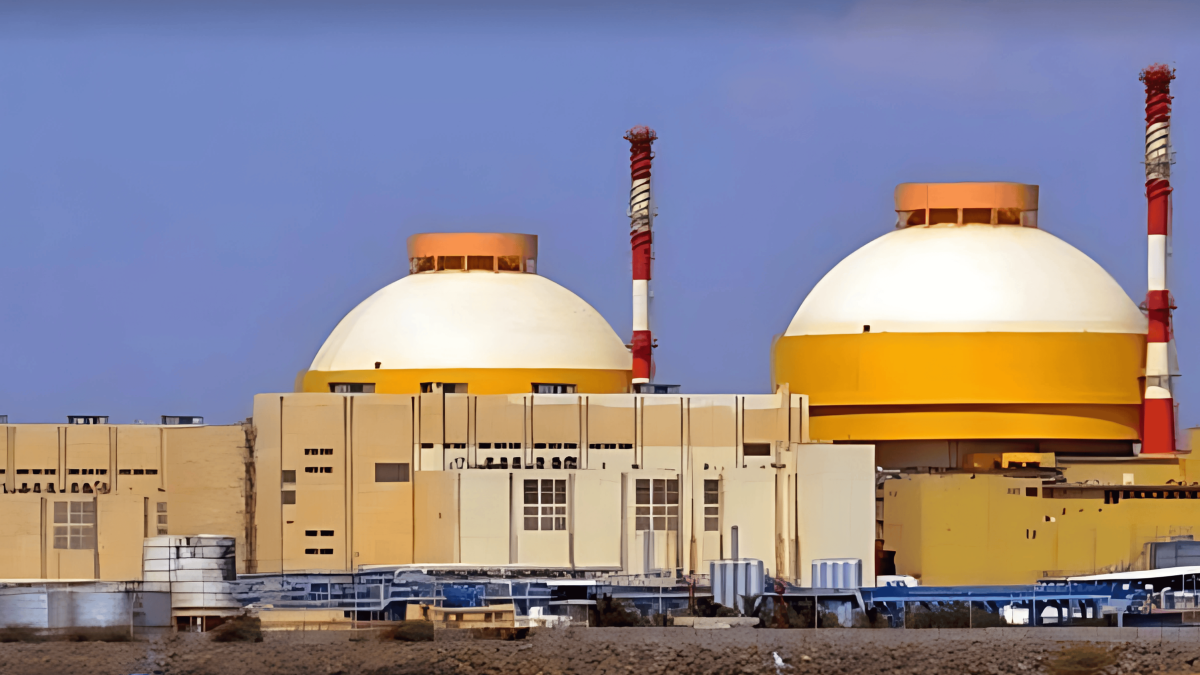Finite Element Analysis (FEA) in the Nuclear Ecosystem: Enhancing Safety and Performance

Unlocking the Power of FEA in API 579 Fitness-for-Service Evaluations: A Deep Dive into Pressure Vessel Integrity
January 9, 2025
Optimizing Car Park Ventilation: A Computational Fluid Dynamics (CFD) Approach
March 11, 2025At Analyzer CAE Solutions, we understand that precision and safety are non-negotiable in the nuclear ecosystem. Finite Element Analysis (FEA) serves as a cornerstone for ensuring the structural integrity and performance of critical components in nuclear power systems. From reactor cores to containment vessels, FEA allows us to simulate and analyse material behaviour under extreme conditions, including high temperatures, pressure loads, and seismic forces.
Our expertise in FEA helps identify potential vulnerabilities, optimize designs, and ensure compliance with stringent industry regulations. By leveraging cutting-edge simulation tools, Analyzer enables engineers to mitigate risks and enhance the reliability of vital infrastructure, ensuring safe and efficient operation throughout the lifecycle of nuclear facilities.
At Analyzer CAE Solutions, we are proud to contribute to the advancement of nuclear energy by combining innovative FEA techniques with a commitment to safety, efficiency, and sustainability. Our work ensures that the nuclear industry meets its dual mandate of technological progress and uncompromised safety.
FEA plays a pivotal role in various critical areas, from optimizing the design of radioactive air filters to assessing the structural integrity of plant infrastructure. By incorporating well-established industry standards and codes.
Analyzer service offerings
Analyzer delivers a comprehensive range of engineering services tailored to ensure safety, precision, and performance. Our expertise encompasses Seismic Analysis, Finite Element Analysis (FEA), and Floor Response Spectra (FRS) Analysis, enabling the resolution of complex challenges across critical industries.
With a strong focus on Skid Engineering and Design, Analyzer integrates advanced techniques such as Air Crash (AC) and Air Shock Wave (ASW) analysis. These state-of-the-art methodologies provide precise insights into structural behaviour under extreme conditions, leading to optimized solutions that enhance reliability and efficiency.
Analyzer is dedicated to offering fully Code-Compliant Solutions that emphasize structural integrity and performance. By combining innovation with technical excellence, we empower industries to address engineering challenges while ensuring sustainable and secure operations.
Analyzer has successfully delivered numerous critical projects across various industries, showcasing our expertise in advanced engineering analysis and innovative solutions. Below are some of our key projects that highlight our commitment to excellence and safety.
Finite element analysis of Radioactive Air Filters
Ensuring the safety and reliability of Radioactive Air Filters and Personnel Survival Systems is critical in high-risk environments. At Analyzer, Finite Element Analysis (FEA) is employed to assess their structural integrity and seismic performance under various extreme conditions, including Operating Basis Earthquake (OBE), Safe Shutdown Earthquake (SSE), Air Shock Waves (ASW), and Accidental Conditions (AC).
By evaluating key components—such as support channels, structural bolts, welds, and duct plates—FEA ensures that these filters meet stringent safety standards. The analysis follows industry-recognized codes, including ASME Section III NF, ASME AG-1, and ASME Section II Part D, verifying that all components withstand tensile, shear, and bending stresses across all load combinations. Modal analysis further validates structural stability, while welds are qualified per ASME NF-3320 standards. Structural bolts and duct plates successfully pass stress evaluations, confirming their resilience during seismic events.
The findings reinforce that the air filter assembly is structurally sound, robust, and fully compliant with industry safety standards, ensuring reliable performance in critical applications.

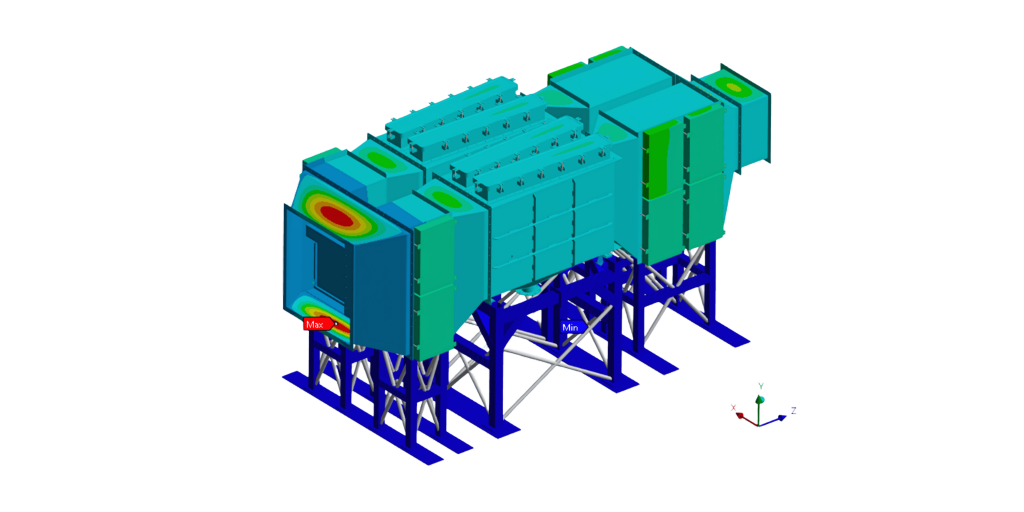
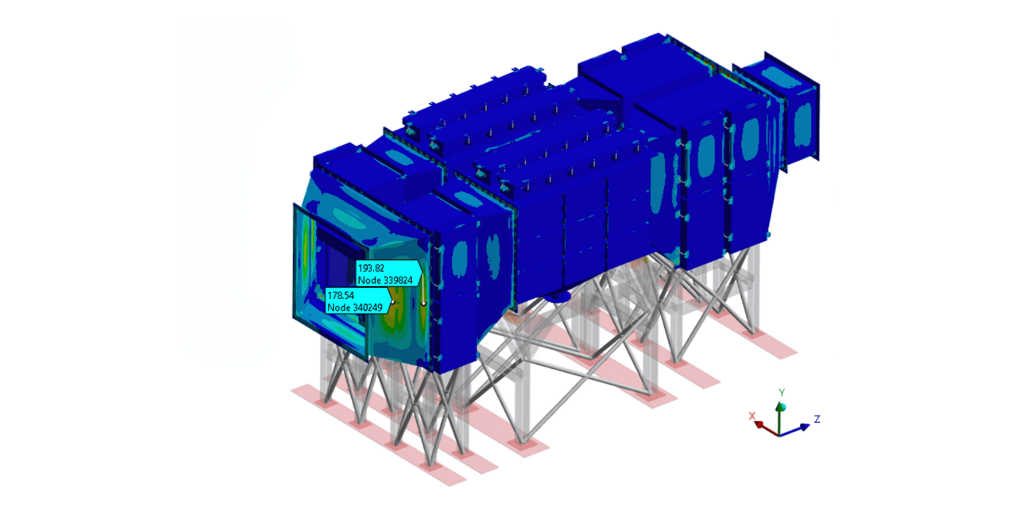
Piping System Stress Analysis
Ensuring the structural integrity of fire protection systems under seismic conditions is crucial for maintaining safety and operational reliability. Analyzer conducted a Finite Element Analysis (FEA) to assess the resilience of piping networks, structural supports, and cylinder assemblies under multiple load scenarios, including dead weight, thermal loads, design pressure, and seismic events such as Operating Basis Earthquake (OBE), Safe Shutdown Earthquake (SSE), and Air Shock Waves (ASW).
The evaluation followed industry standards, including ASME B31.1 for piping systems and ASME Section III NF for structural supports, ensuring compliance with safety regulations. Key structural elements—such as U-bolts, anchor bolts, welds, and base plates—were tested for tensile, shear, bending, and buckling resistance under seismic stress conditions. Additionally, modal analysis confirmed the dynamic stability of support components, including U-bolts and C-channels, verifying their ability to sustain seismic loads without compromising functionality.
The results demonstrated that the firefighting system’s components are structurally robust, meet seismic design standards, and can maintain operational reliability during extreme events. This analysis ensures that critical safety systems remain functional in high-risk environments, reinforcing their role in emergency response and hazard mitigation.
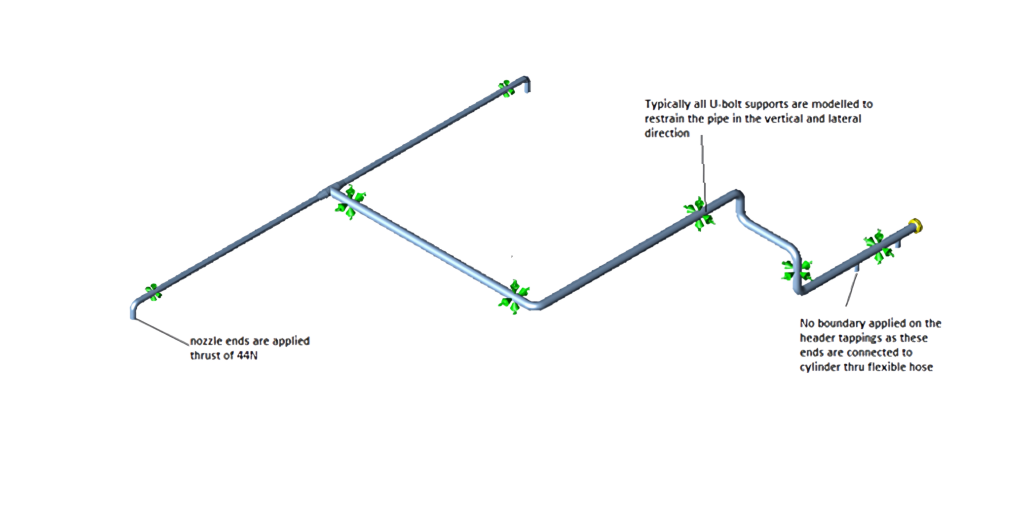
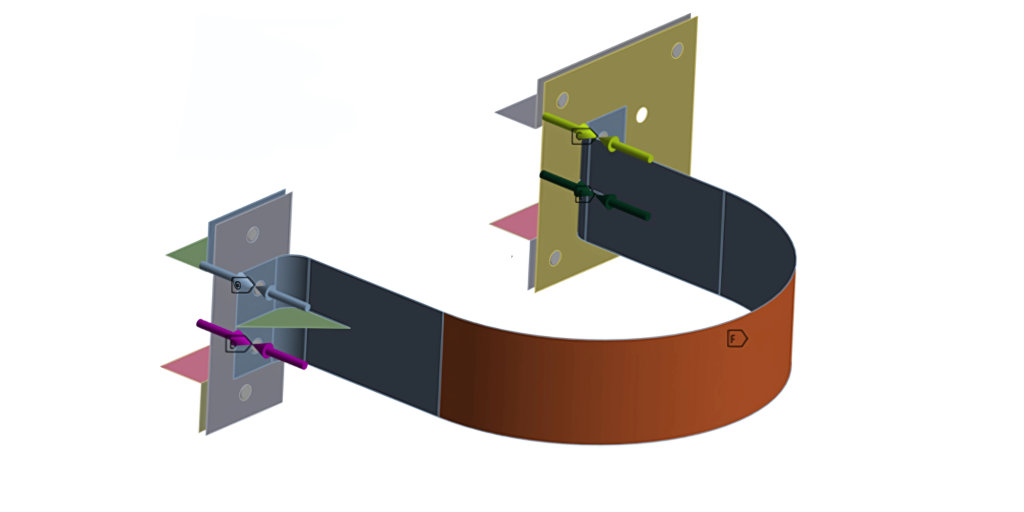
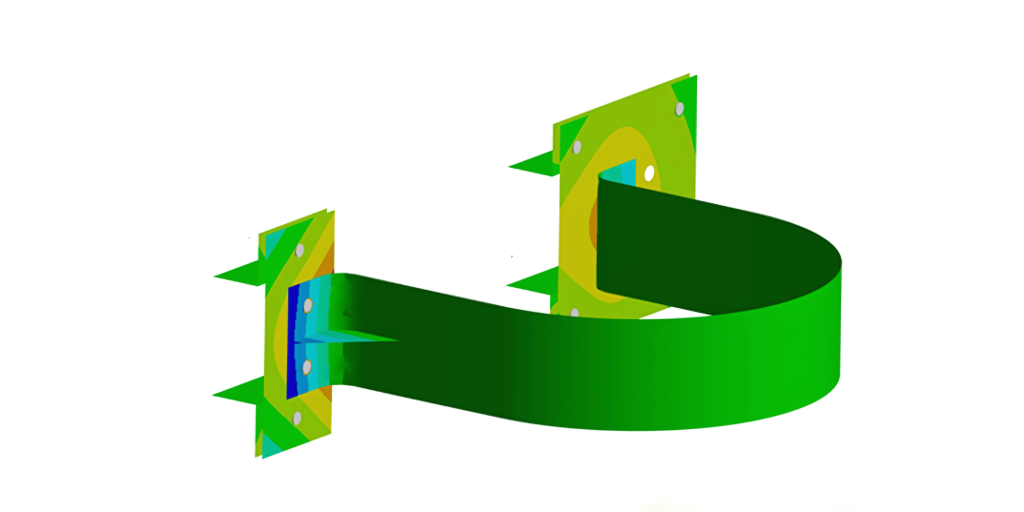
Seismic Analysis of Critical Cooling Systems
Ensuring the structural integrity of critical cooling systems under seismic and operational loading conditions is essential for maintaining safety in high-risk environments. Analyzer conducted a Finite Element Analysis (FEA) to evaluate the response of a heat exchanger to multiple load conditions, including dead weight, internal pressure, nozzle loads, and seismic events such as Operating Basis Earthquake (OBE) and Safe Shutdown Earthquake (SSE).
The analysis adhered to ASME Section III, Division I, ensuring compliance with nuclear industry safety standards for pressure and support components. Key structural elements—including frame plates, pressure plates, tie bolts, support columns, and base plates—were assessed for tensile, shear, and bending stresses under various loading scenarios. Results confirmed that all components remained within allowable stress limits, with no risk of structural failure. Additionally, modal analysis verified sufficient natural frequencies to prevent resonance, further ensuring the system’s stability.
The evaluation concluded that the heat exchanger is structurally sound, compliant with seismic safety standards, and capable of maintaining operational reliability under extreme conditions. Site-specific recommendations, such as proper bolt preloading and foundation alignment, were suggested to enhance performance during seismic events.
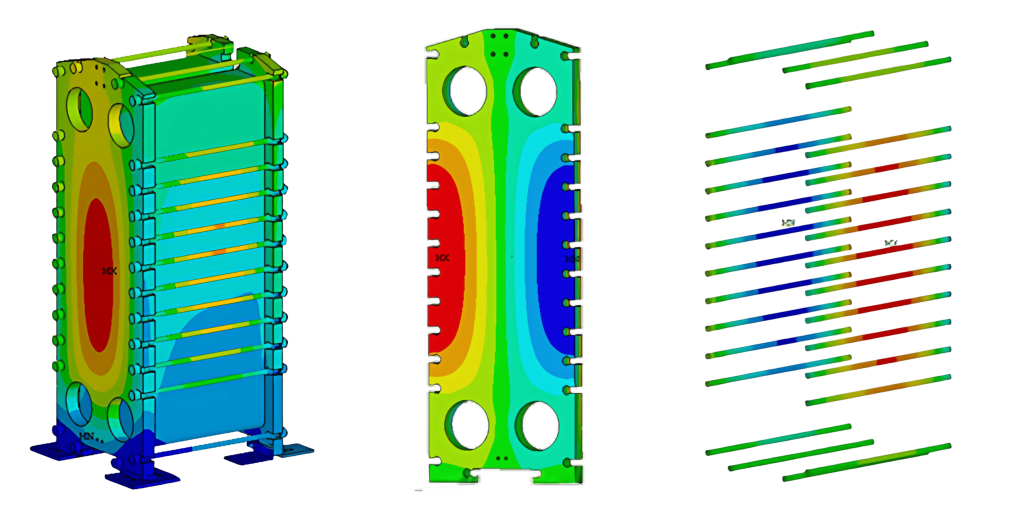
Ensuring Structural Integrity of Critical Pumps in Nuclear Applications
In nuclear applications, pumps must operate reliably under extreme conditions. Finite Element Analysis (FEA) is employed to evaluate the structural integrity of critical pump components, including casings, tie bolts, front-end bells, flanges, and nozzles. This analysis assesses performance under various loading scenarios such as dead weight, internal pressure, nozzle loads, and seismic events. Compliance with industry standards is achieved by following guidelines like ASME BPVC Section III and IS 1893 for seismic stability. Seismic loads, including Operating Basis Earthquakes (OBE) and Safe Shutdown Earthquakes (SSE), are applied to ensure that pumps maintain structural stability under both horizontal and vertical forces.
FEA helps identify areas where stress levels approach or exceed allowable limits. While most components consistently meet design requirements, certain sections—especially the nozzle areas—sometimes require further optimization to achieve full compliance. Additional recommendations include ensuring proper bolt preloading, foundation alignment, and careful material selection to enhance durability and performance. Modal analysis is also performed to verify that the natural frequency responses of the system prevent resonance issues.
Through iterative design evaluations, engineers refine pump designs so that all pressure-retaining elements, such as casings, flanges, shafts, and fasteners, comply with stringent nuclear safety standards. This comprehensive approach to structural evaluation not only ensures robust performance during seismic events but also contributes significantly to long-term operational reliability and safety in mission-critical nuclear environments.
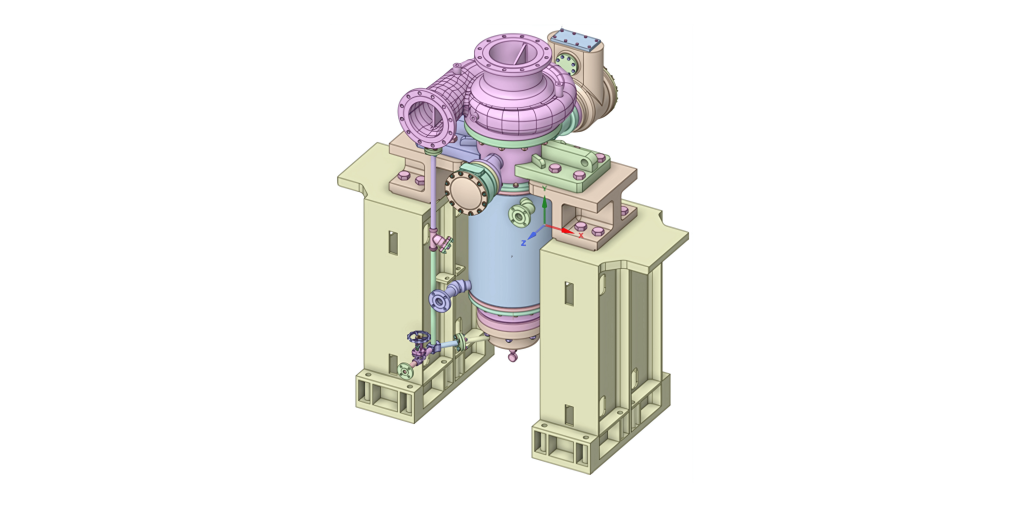
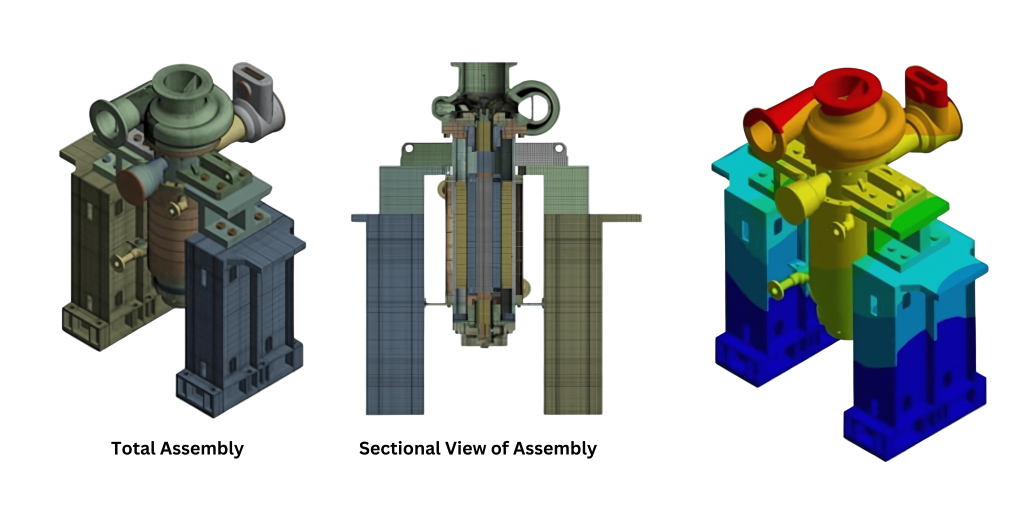
Ensuring Structural Integrity: Finite Element Analysis of a Horizontal Screw Pump
Structural integrity and reliability are crucial in engineering systems, particularly those operating in high-risk environments such as nuclear facilities. A comprehensive Finite Element Analysis (FEA) was conducted to evaluate the performance of a horizontal screw pump under various operational and extreme loading conditions. The assessment focused on critical structural components, including the base frame, hold-down bolts, and welds, ensuring compliance with industry safety and performance standards, such as ASME Section III, Division I, Subsections NC & NF.
The pump was analysed under different load scenarios, including self-weight, internal pressure, nozzle forces, torque, and seismic conditions like the Operating Basis Earthquake (OBE). Stress evaluations of key components, such as the rotor, stator sleeve, shaft, and foundation welds, confirmed that all stress levels remained well within permissible limits. Additionally, a modal analysis was conducted to assess vibrational characteristics, ensuring that the pump’s natural frequencies were sufficient to avoid resonance-related failures.
Further evaluations were carried out on the geared motor unit to verify its operability under seismic events. The structural assessment confirmed that the foundation welds successfully met strength criteria, reinforcing the pump’s stability and durability. The final results concluded that the pump assembly is not only structurally sound but also meets stringent nuclear safety codes, ensuring reliable performance even in extreme conditions. These findings validate the pump’s readiness for deployment in seismic-sensitive environments, highlighting its robust design and adherence to safety regulations for critical applications.


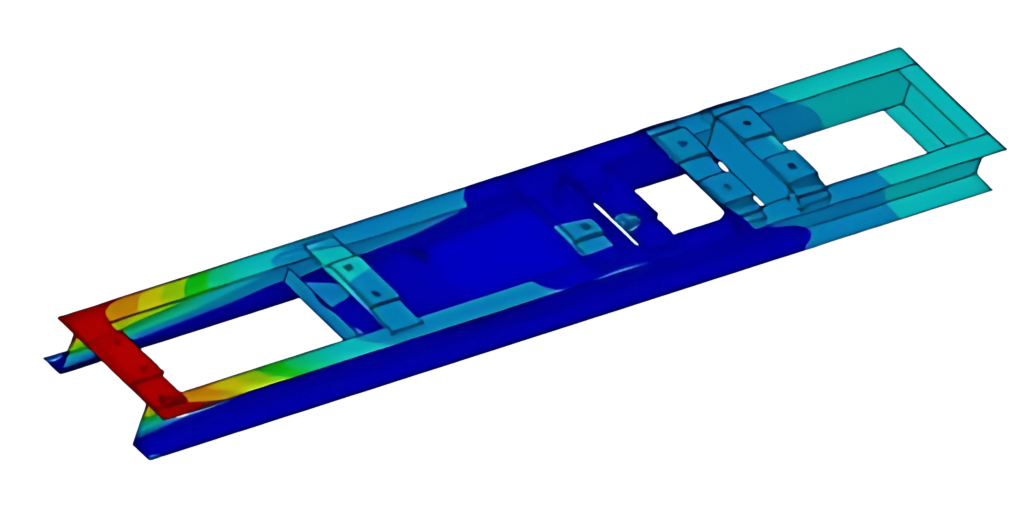
Finite Element Analysis (FEA) for the Storage Racks
Ensuring the structural safety of storage systems in high-risk environments is crucial, especially in facilities handling critical equipment. Finite Element Analysis (FEA) plays a key role in assessing the performance of storage racks under various loading conditions, including static loads and seismic events. This analysis, conducted using advanced simulation tools like ANSYS, evaluates structural integrity and compliance with established safety codes.
The study considers multiple design parameters, such as dead loads (DL) and seismic forces like the Operating Basis Earthquake (OBE), to determine stress distribution and overall stability. Structural components, including guide channels, support beams, and secondary frameworks, undergo stress evaluation under different load combinations. Modal analysis further validates the design by confirming safe natural frequencies, effectively minimizing resonance risks.
Adhering to standards such as IS 800, IS 2062, and ASME Section II Part D, the assessment ensures that all structural elements meet the required safety thresholds. The findings confirm that the storage racks can withstand seismic disturbances without compromising their function, ensuring the secure storage of essential components in critical facilities.
By meeting rigorous safety and design criteria, the validated storage racks contribute to long-term operational reliability in sectors like nuclear power and industrial facilities. Their robust construction ensures resilience against external forces, reinforcing their role in maintaining the integrity of high-value assets.
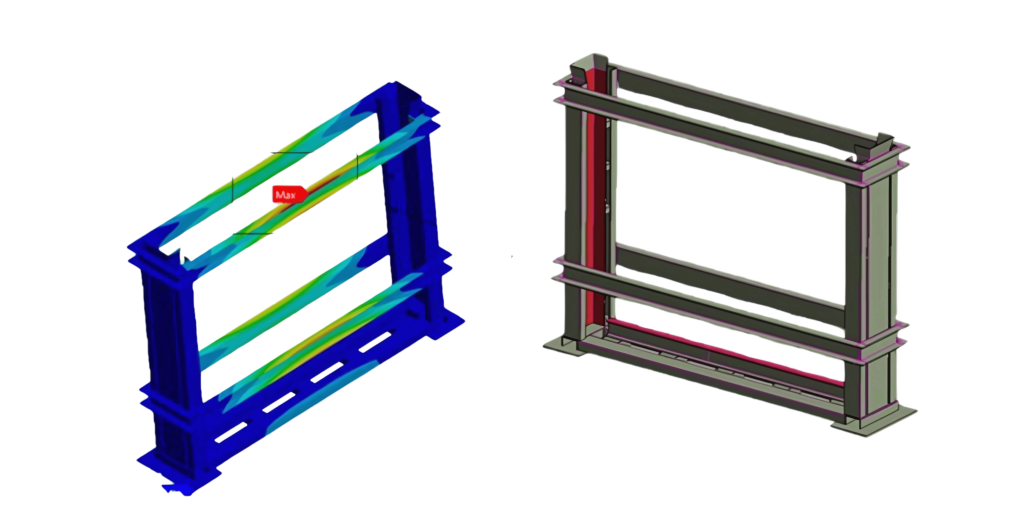
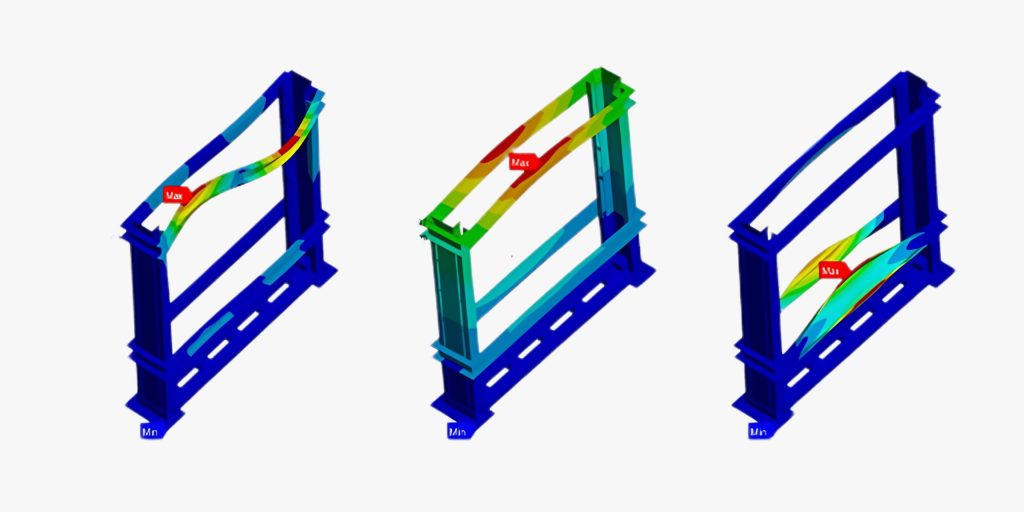
Seismic Analysis of Control Panels for Safety-Critical Systems
Ensuring the structural integrity of control panels in safety-critical systems is essential for maintaining reliable operations under both normal and extreme conditions. Finite Element Analysis (FEA) is widely used to evaluate these panels against various load scenarios, including self-weight, seismic forces, and external shock waves.
Following established safety codes such as ASME Section III, Division I, and ASME Section II, Part D, structural assessments focus on key components like sheet panels, welded supports, and fastening elements. By simulating real-world conditions, engineers can assess stress distribution, deformation limits, and overall stability. Modal analysis helps verify that natural frequencies do not coincide with operational vibrations, reducing the risk of resonance.
Seismic qualification is particularly crucial for equipment used in critical environments, such as nuclear facilities, where structural failure could lead to operational disruptions. By subjecting control panels to various seismic loads, including Design Basis Earthquake (DBE) and Safe Shutdown Earthquake (SSE), their ability to withstand extreme events is validated. Stress analysis ensures that welded connections and supporting frameworks remain within permissible limits, safeguarding the system’s reliability.
Comprehensive analysis confirms that well-designed control panels meet stringent safety standards, ensuring long-term performance in high-risk environments. This robust approach reinforces confidence in their deployment across industries where structural resilience and operational safety are paramount.
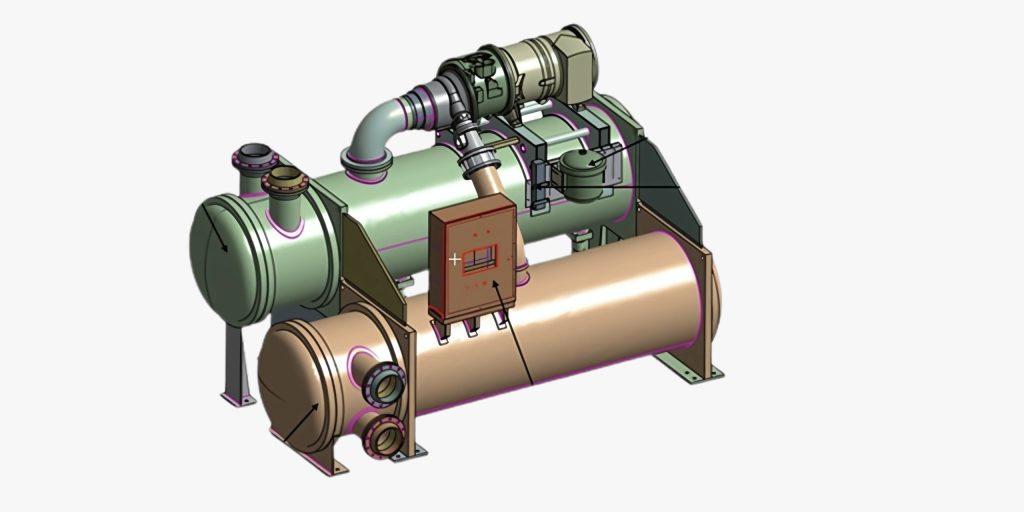

Design calculation for the Liquid Ring Vacuum Pump
The Liquid Ring Vacuum Pump (LRVP) represents a modern approach to creating process vacuums in high-stakes industrial systems. At its core, this single-stage, horizontal centrifugal pump is engineered to meet rigorous safety and performance standards, making it well-suited for applications where reliability is paramount. Developed with a focus on structural integrity, the design adheres to internationally recognized standards, ensuring that every component—from the robust casing to the meticulously designed flanges and tie bolts—is capable of withstanding diverse operational stresses.
Key to the pump’s design is its ability to perform under demanding conditions, including the challenges posed by seismic events. The pump has been carefully evaluated to ensure it can handle both internal and external pressures, as well as dynamic forces such as those experienced during earthquakes. This commitment to safety is further underscored by design refinements, such as optimizing component thickness based on detailed calculations, which enhance overall durability and operational resilience.
While the LRVP was initially tailored for a specific high-pressure system, its innovative features and stringent adherence to quality standards make it a benchmark for vacuum technology across various sectors. Its reliable performance in maintaining precise vacuum conditions is essential in settings where even slight deviations can impact process efficiency and safety. Ultimately, this pump is not just an example of advanced engineering; it is a testament to the meticulous balance of precision design, rigorous testing, and adherence to safety norms that drive progress in critical industrial applications.
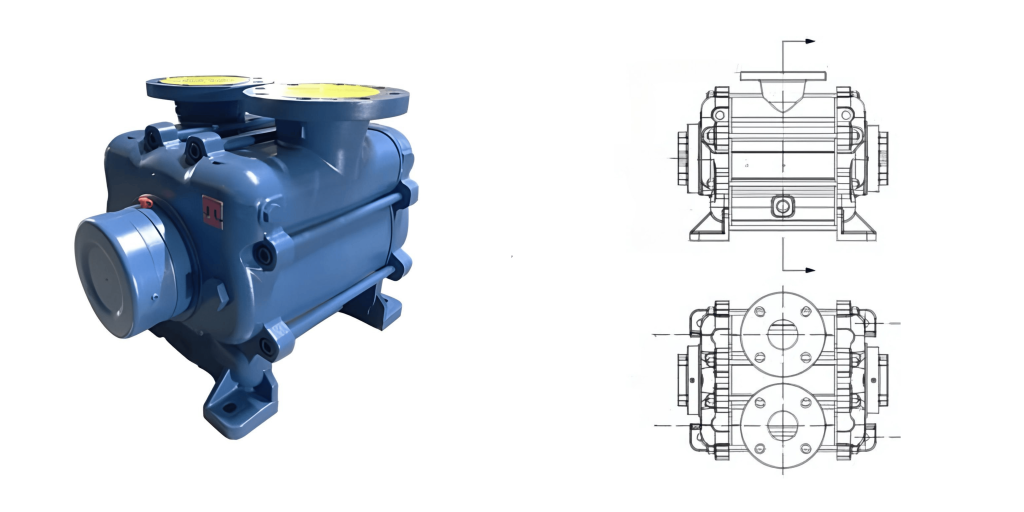
Torsional Analysis of Primary Coolant Pump
A detailed torsional analysis was undertaken to ensure that critical rotating machinery, such as primary coolant pumps in nuclear power plants, performs safely and reliably under a variety of operating conditions. The study focused on understanding the dynamic behaviour of key components—including motor shafts, couplings, and pump shafts—by identifying natural frequencies and evaluating stress levels. This analysis was essential to avoid resonance with operational speeds, which could lead to detrimental vibrations and potential mechanical failure. Advanced finite element modelling techniques were employed to simulate transient conditions such as motor startups, short circuit events, and power transfers. These simulations helped in mapping the distribution of torsional stresses and moments across the system, ensuring that every component remains within safe operational limits. By verifying that natural frequencies were sufficiently separated from the excitation frequencies encountered during normal operations, the study confirmed that resonance conditions would be effectively mitigated. Furthermore, transient torsional stresses were found to be well within the design criteria, affirming the robustness and reliability of the pump system. This approach not only bolsters confidence in the durability of the machinery but also reinforces the safety standards required in high-demand, high-risk environments like nuclear reactors. Overall, the insights gained from this analysis contribute to a broader understanding of mechanical integrity in critical systems, ensuring that even under dynamic and potentially challenging scenarios, the performance and safety of these vital components are uncompromised.

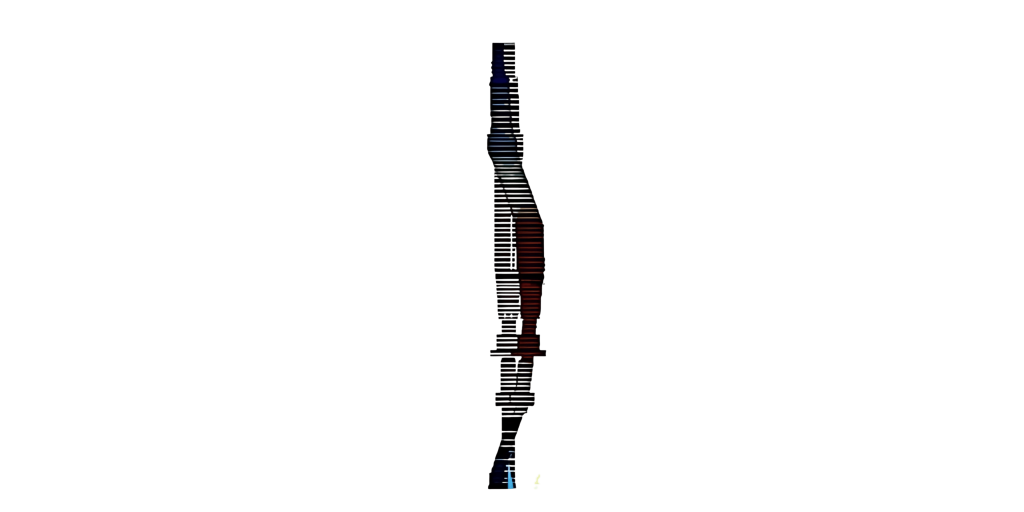
Lateral Analysis of Primary Coolant Pump Motor
A comprehensive analysis was conducted to ensure the reliability and safety of rotating machinery in critical applications. The study focused on evaluating the dynamic behaviour of a motor shaft, particularly its lateral vibrations and response to unbalanced forces under different loading conditions. Using advanced Finite Element Analysis (FEA), engineers examined the system’s modal characteristics and harmonic response, considering factors such as damping, dynamic forces, and Coriolis effects. Various operational scenarios, including upward and downward thrust conditions, were simulated to assess structural stability and performance.
Key findings confirmed that all lateral frequencies remained outside critical operational ranges, effectively mitigating resonance risks. Further harmonic analysis examined the impact of unbalanced forces at different speeds, ensuring that deflections in essential components—such as the motor shaft, rotor, and thrust pads—remained within safe limits. This reinforced the design’s robustness, minimizing the likelihood of deformation or misalignment that could affect operational efficiency.
By leveraging state-of-the-art modelling techniques, including bonded contact interfaces and material adjustments, the analysis provided a highly accurate representation of real-world conditions. The results validated the system’s ability to meet stringent performance standards, ensuring reliability in high-stakes environments. This study highlights the significance of precise engineering assessments in optimizing the performance of essential infrastructure components, demonstrating how cutting-edge analytical methods can address complex mechanical challenges in demanding industrial settings.
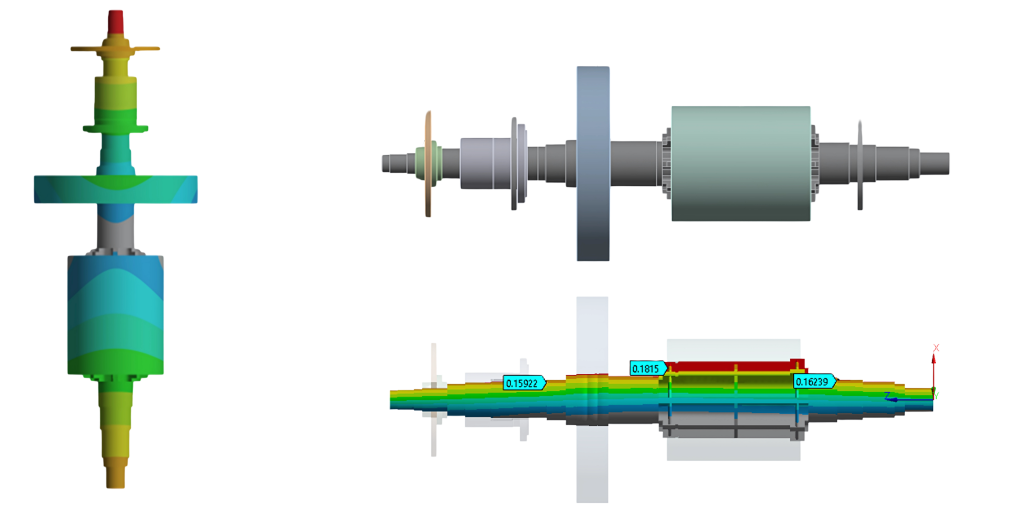
Comprehensive CAE Services We Offer
Finite Element Analysis (FEA):
- Structural Analysis
- Linear and Nonlinear Analysis
- Static and Dynamic Load Assessment
- Thermal-Structural Coupled Analysis
- Modal and Vibration Analysis
- Modal Frequency Analysis
- Harmonic and Transient Vibration Analysis
- Rotational and Lateral Vibration Studies
- Thermal Analysis
- Steady-State and Transient Thermal Analysis
- Heat Transfer Studies (Conduction, Convection, Radiation)
- Fatigue and Fracture Analysis
- Life Cycle Prediction
- Crack Propagation Studies
- Low and High Cycle Fatigue Analysis
- Seismic and Impact Analysis
- Earthquake Resistance Evaluation
- Crashworthiness and Impact Studies
- Fluid-Structure Interaction (FSI)
- Coupled FEA and CFD for Interaction Studies
Computational Fluid Dynamics (CFD):
- Flow Analysis
- Steady and Transient Flow Simulation
- Compressible and Incompressible Fluid Flow
- Thermal Fluid Analysis
- Heat Transfer in Fluids
- Conjugate Heat Transfer
- Multiphase Flow Analysis
- Liquid-Gas Interactions
- Particle Dynamics in Fluid Streams
- Aero and Hydrodynamics
- Drag and Lift Optimization
- Flow Around Structures
- Turbulence Modelling
- RANS, LES, and DNS Approaches
- Specialized Applications
- HVAC System Design
- Environmental and Pollution Control Studies
Computer-Aided Design (CAD):
- 3D Modelling and Drafting
- Part and Assembly Modelling
- Complex Geometry Creation
- Design Optimization
- Weight and Material Optimization
- Design for Manufacturability
- Reverse Engineering
- 3D Scanning and Model Reconstruction
- Legacy Design Updates
- Detailed Engineering Drawings
- GD&T (Geometric Dimensioning & Tolerancing)
- Bill of Materials (BOM) Generation
- Simulation-Ready CAD Models
- CAD Preparation for FEA/CFD Analysis
- Integration with Analytical Software
- Industry-Specific CAD Solutions
- Tooling and Fixture Design
- Automotive, Aerospace, and Machinery Components
Why to Choose Analyzer?
When facing complex challenges in the nuclear sector, choosing a partner with deep technical expertise and precise engineering capabilities is essential. At Analyzer CAE Solutions, we specialize in advanced Finite Element Analysis (FEA) that spans a broad range of critical evaluations—from seismic assessments to detailed stress analyses and codal compliance checks in line with industry standards such as those from ASME. Our comprehensive simulations account for a variety of load conditions, including dead weight, thermal effects, design pressure, and dynamic events such as operating basis and safe shutdown earthquakes, as well as impacts from air shock waves. This multifaceted approach ensures that our designs are robust enough to withstand even the most extreme scenarios.
Our track record includes successful seismic assessments of essential systems like firefighting networks and control panels within nuclear power projects, providing our clients with validated solutions that guarantee structural integrity, operational stability, and regulatory compliance. By leveraging cutting-edge analytical tools and state-of-the-art methodologies, we not only optimize safety margins but also enhance the overall reliability of critical infrastructure components.
At Analyzer CAE Solutions, we are committed to delivering engineered solutions that meet the highest safety and performance standards. Our expertise is built on a foundation of precision analysis and practical experience, making us a trusted partner in ensuring that every project we undertake is equipped to handle the challenges of today’s demanding nuclear environment. Experience unparalleled accuracy and a dedicated commitment to quality by partnering with us for your next project.


